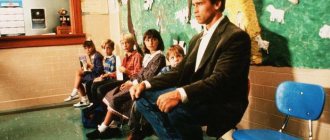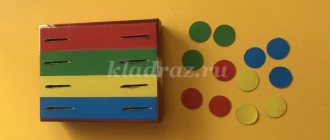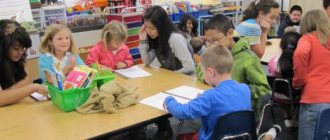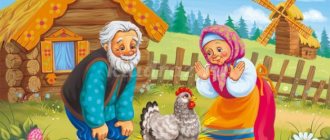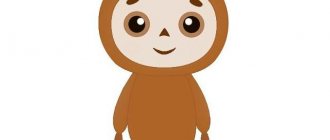Article: “Open lesson on FEMP in the first junior group. "Bunny Stepashka is visiting"
Open lesson on FEMP in the first junior group.
“Bunny Stepashka is visiting”
Objectives: To consolidate knowledge about geometric shapes, answer the question “how many?” ” in words one, many, none.
Continue to develop the ability to form a group of individual objects and isolate one object from it.
Preliminary work: Teach children to pay attention to the shape of objects when performing basic actions with toys and objects in everyday life.
Examination of one and many objects.
Game “Find an object of the same shape in the group.”
Program content. Educational objectives
— continue to teach children to conduct a dialogue with the teacher: listen and understand the question asked and answer it clearly;
- consolidate and generalize children’s knowledge about the number of objects (one, many, none,
-To consolidate the ability to distinguish and name primary colors: red, blue, yellow, green;
— Developmental tasks:
-Develop auditory and visual attention, imagination.
-Develop speech, observation, mental activity -Expand and activate children's vocabulary.
-Develop logical thinking.
Educational tasks:
-Cultivate a desire to work;
-Cultivate kindness and responsiveness.
Equipment and materials:
Demonstration: soft toy Bunny. Large and small cubes. Big and small box
Handouts: Large and small cubes according to the number of children. One plate per child. Blue circles in rosettes for each child.
Venue: group (on the carpet and at tables)
Progress of the lesson
- Introduction to the educational game situation
Introduction of the fairy-tale hero Bunny-Stepashka.
- Guys, a guest will come to us today, I’ll tell you a riddle, and you guess who he is?
Lives in a hole and gnaws carrots
Agility runs away from the fox and the wolf (who is it)
children's answers (bunny)
- That's right, this is a bunny, his name is Stepashka.
- Main part.
- Game – task “Put the cubes into boxes” (on the carpet)
Educator:
Guys, our Stepashka is sad. Stepashka why are you so sad?
-Guys, he says that two boxes of cubes fell apart. Really look at how many cubes there are on our carpet. Let's look at them: - Egor, what are the size of the cubes (larger and small). What color are the cubes?
Children name colors (blue, yellow, red, green)
— The Bunny asks to put the cubes into boxes: large cubes into a large box, and small ones into a small box, let us help the Bunny. Look at your cubes. Show the big cube (show) Show the small one (show)
On the teacher’s table there are demonstration cubes: large and small. The teacher is the first to lay out the boxes, accompanying the actions with speech.
-Look, what kind of box is this? (large)
-What is this box? (small)
-Guys, I’ll put the big cube in a large box, and the small one in a small box (the children complete the tasks after the teacher’s explanation, come up one at a time and put the cubes in boxes.)
-So we helped the Bunny: we put the large cubes in a large box, and the small ones in a small box. The bunny is happy, he smiles.
Physical education minute; One two three four five. The bunnies went out for a walk.
Suddenly the hunter runs out and shoots straight at the bunny.
Beer-pav-oh-oh. My little bunny is running away!
Children, let's invite the Bunny to play with us at the tables.
- Game task “one and many” (at tables)
Plates are laid out on the table. Each child has his own white plate and a box with handouts (blue circles.)
Educator: Children, you have a white plate on your table. What shape is it (round). And there are also boxes in front of you, what’s in them (circles) What color are they? (blue) how many circles? (a lot). And on plates (not a single one.)
Now you take one mug at a time and place it on your plate. How many circles did you have on the plate (one at a time). And how many were left in the box (many). Now make sure that there are many circles on the plate, but not a single one in the box. Children complete the task.
How many mugs are in the box? (no one)
And you have (a lot) on your plate. Guys, look, how many circles does Bunny have on his plate? (no one). Let's each of you put one mug on his plate.
-Vika, how many circles will you put in (one)
-Mila, how old are you? (one)
One, one, one, look. How many circles did Bunny collect from you (many)
There was not one, but there were many. Let's give this plate to the Bunny.
“Thank you children! “- Stepashka tells you.
That's how great you and I were, helping to collect large and small cubes for Bunny and laying out the circles (one, many, none! Well done!
Guys, do you know what holiday is coming soon (New Year)
- Game - round dance: The winter sun rises, he sees a bunny coming.
-Where are you going barefoot through the snow?
It's freezing outside now, you'll freeze your tail and nose off.
-I’m not afraid of the frost, I’m in a hurry to get to the Christmas tree
In kindergarten I was invited to dance in an elegant hall!
Children and their teacher dance in a circle around the Christmas tree and say to Bunny - Goodbye!
Summary of an open lesson on FEMP in the first junior group “Geometric Figures”
The teacher suggests tracing a circle with your finger.
Educator: Let's look further:
- I have three tops, three corners, three sides. Who am I?
Children: Triangle.
He takes out a triangle and attaches it next to the circle: “What else did the Bunny bring us? What is the name of this figure?
The teacher invites the children to repeat the name of the figure in chorus, and for some children to show its sides and angles.
Educator: Well done! And here is another figure:
“I’m not an oval, I’m not a circle, I’m not a friend to a triangle,
This is the kind of brother I am.
And my name is...
Children: Square.
Then he takes out a square, places it next to the triangle, names the figure, shows the sides and corners of the square and asks the children: “What does a square have? How many sides does a square have? How many angles does a square have?
The teacher asks the children to circle the square and show its sides (corners).
The teacher summarizes the children's answers and actions.
part 2
. Educator: “What great fellows you all are. They correctly named all the geometric shapes that Bunny brought. I think he really enjoyed being with you, and he offers to warm up a little.
Physical school
The little gray bunny sits and wiggles his ears!
(Children squat down and use their hands to imitate how a bunny moves its ears)
Just like that, like that, and he moves his ears!
It's cold for the bunny to sit, we need to warm his little paws,
That's it, that's it, we need to warm our little paws!
(Children lightly clap palm to palm, then stand up)
It's cold for the bunny to stand, the bunny needs to jump!
Hop - hop - hop - hop, the bunny needs to jump!
(Children jump on two legs, pressing their hands to their chest)
Someone scared the bunny, the bunny jumped and ran away.
(The children scatter in all directions, and the teacher takes the fox and runs after the bunnies)
Educator: - Well done! The bunny told me that in our group there are a lot of objects that have the same shape as his gifts - a circle, a square, a triangle. And he offers to find them.
Look, under each of you there is a card with a picture of a circle, square, triangle. Take them and look at them. Then look carefully at our group and find something round, square, triangular.
(Children, in accordance with the image on the card, find the necessary objects of round, square, triangular shape.)
Educator: Well done, you also coped with this task.
Part 3.
Outdoor game "Find your house."
There is a circle, a triangle and a square on the tables. Children take one geometric figure that was under their chairs and call them the keys to the house (hoop). Children with keys go to the carpet and begin to move to the music. At the end of the melody, the teacher says that it is night and they must find their houses: those with a circle in their hands run to the circle, those with a triangle run to the triangle, those with a square run to the square. When the children take their places, the teacher asks them to justify their choice.
Summary of an open lesson on cognitive development in the first junior group
SUMMARY OF AN OPEN LESSON
ON COGNITIVE DEVELOPMENT EXPERIMENTAL ACTIVITY IN THE FIRST JUNIOR GROUP (2-3 years) MBDOU DS No. 239
Performed by: teacher N.N. Petrukhina
Chelyabinsk 2021 Lesson topic
: Sand streams and wonderful figures.
Goal:
to introduce children to the properties of sand.
Tasks:
- Generate interest in experimental activities
- Develop fine motor skills of the hands and coordination of movements
- Activate the words in children’s speech: loose sand, wet
- Develop curiosity, curiosity, aesthetic perception.
Preliminary work
: reading fiction, looking at illustrations on the theme “Playing with sand.”
Materials and equipment
: a jar of sand, sand molds, scoops, modeling boards, wet wipes, a bunny toy.
Progress of the lesson: Organizational moment: Teacher (shows a toy bunny in whose paws there is a transparent jar of sand): Guys, look who came to visit us? Children: Bunny. Educator: Let's say hello to him. Children say hello. Educator: Bunny, what’s in your paws? Did you bring us something? Educator (on behalf of the bunny): I’m small and don’t know what it is. I think the guys will tell me. Educator: Guys, can we help the bunny? Main part: Educator: Guys, what is in the bunny’s jar? Children: sand Teacher: Let's pour sand onto the board. Guys, touch the sand and tell me what it is like. Children: dry, crumbling. Educator: Bunny, remember - this sand is dry, free-flowing (children repeat). Pour it onto your palm (children do). Look what sand is made of? (children's answers) Let's say together: they are made of grains of sand, they are small (children repeat) How difficult it is to hold them in your hands. The grains of sand fall like a trickle. This sand is dry (the teacher accompanies his words with a demonstration of experience). Educator: Guys, do you know that you can draw in the sand? (the teacher shows the children how to draw with a finger in the sand) The children repeat the actions of the teacher (try to draw with a finger).
Fizkul Mishka was walking through the forest, and he was looking for children. He searched for a long, long time, sat down on the grass and dozed off. The children began to dance, They began to knock with their feet: Misha, Mishenka, get up, And catch up with the children! (children run away from the bear, he catches up with them). Educator: Guys, we have molds on the table. Let's pour sand into the mold. Let's see. Whether we get a little Easter cake or not. Carefully pour sand into the mold. Educator: Did you get Easter cakes? (children’s answers). Why didn't it work out? (sand is dry) Educator: Guys, to make Easter cakes, what should you do with the sand? (children answer) Educator: We need to get it wet. Let's check. The teacher pours water into the sand. Educator: Touch it and tell me - is it dry or wet? (children answer) Educator: Bunny, remember, if you pour water into the sand, it will become damp, wet. Look, wet sand flows just as well as dry sand? (show to children) Conclusion: Wet sand is not free-flowing. Educator: You can make Easter cakes from wet, damp sand. Let's try. Take a mold and carefully pour wet sand into it. Let's tap the sand with a scoop, compact it, and carefully turn the mold with sand over. Let's knock on the bottom again with a scoop. Let's remove the mold. What happened? (Kulichik). What a beautiful little Easter cake you made! Well done! Children, let's wash our hands and dry them with a towel. Educator: Guys, let's treat the bunny with our Easter cakes! Educator (from the bunny): Guys, it’s time for me to go home. Thanks for the fun activity! Educator: Guys, did you like our lesson? We have become acquainted with sand, that it can be dry and free-flowing. You can also wet it and make wonderful Easter cakes out of it. Goodbye bunny, see you soon. We also enjoyed talking to you, don’t you guys agree? (children answer).
